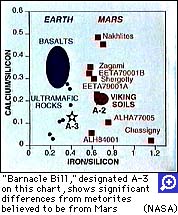
 |
 |

The data from the Sojourner rover's alpha proton X-ray spectrometer suggests that the football-sized rock may be a kind of andesite, the second most common type of lava on Earth.
McSween emphasized that there was no confirmation that Barnacle Bill was formed by volcanic action, and said it could either be sedimentary rock or an "impact" rock caused by a meteorite.
But he did say that its composition is different from meteorites from Mars. He also said that scientists hope an analysis of the soil will help them get a better idea of Mars' geology.
The scientists also revealed that:
Sunrises and sunsets on Mars are longer and brighter than on Earth, owing to the dust. First light on Mars occurs at 3:15 a.m. A day on Mars is similar in length to a day on Earth.
The first observations were made of Deimos, the smaller of Mars' two moons. Thirteen images were beamed back to Earth, and Dr. Nicholas Thomas of the Max Planck Institute in Germany said Deimos would never be more than a "spot" passing over Mars. Phobos, though larger than Deimos, crosses the Martian night sky in four hours, he said.
The weather on Mars is "boring," in the words of Barnes. At 2:45 in the Martian afternoon, the temperature was 5 degrees Fahrenheit, and there was a weak wind from the northwest.
"It's exactly what we expected," Barnes said. However, he added that during the Martian fall which begins in "50 or 60 days," the weather change will be dramatic.
Golombek revealed that the Pathfinder lander bounced more than 16 times on its cushion of air bags before coming to rest in the area called Ares Vallis. And since overcoming a communications glitch over the weekend, everything has worked flawlessly.
 |
|
Sojourner will analyze the Martian surface to determine the chemical composition of its features. Other experiments will explore the feasibility of using solar energy to turn Mars' atmosphere into rocket fuel, a process that may prove necessary if spacecraft are ever to fly from Mars back to Earth.
Both the main landing craft and Sojourner have cameras on board to beam back detailed images of the planet's features.
The mission is designed to last a month before the
Pathfinder is not designed to answer the provocative question of whether life once existed on Mars, because it will not be returning to Earth with the soil or rock samples that would be needed for a definitive answer.
But the data collected on this mission could provide new clues to the answer, as well as giving scientists the information they need for future missions that could offer definite proof of Martian life.